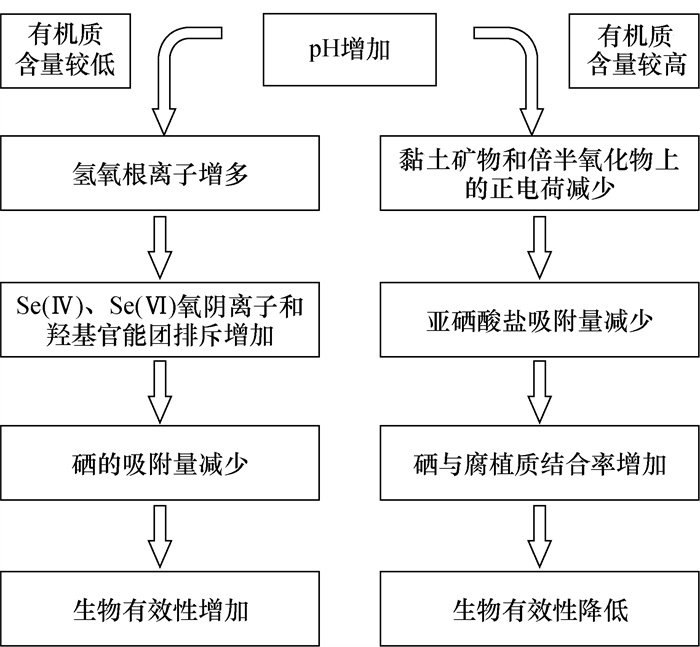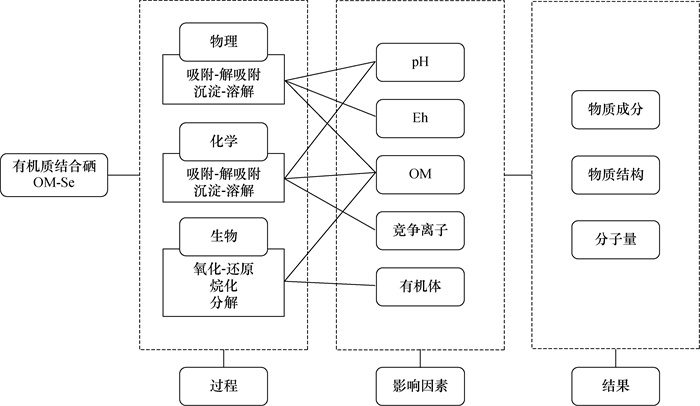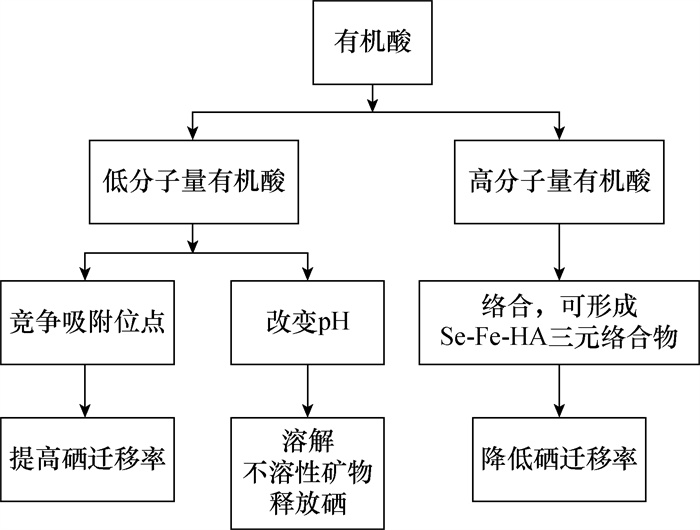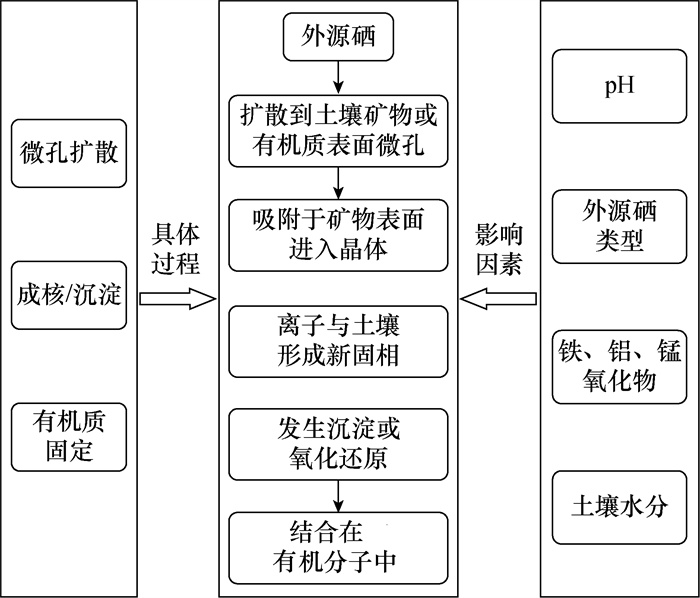A Summary of Research Progress on Bioavailability Assessment Method of Selenium in Soil and Its Influencing Factors
-
摘要:
硒是人体必需的微量元素之一。土壤-植物体系是人体摄入硒的主要途径,但尚缺乏准确评价土壤中硒生物有效性的通用方法,且影响因素也复杂多样, 这些问题制约了富硒土地资源的利用。本文通过追踪近年来国内外研究成果,系统地总结及比较了化学提取法、梯度扩散薄膜法、区域尺度硒生物有效性评价方法的优缺点。传统的化学提取法如单一提取和顺序提取在一定程度上能够表征土壤中生物有效性硒,但提取过程中存在影响因素多和提取不完全等问题。梯度扩散薄膜技术(DGT)能够模拟植物的根系吸收过程,相比顺序提取能更好地表征硒的生物有效性,但由于复杂的自然体系和不同元素结合相的差异,野外原位表征技术上仍存在难度。通过大规模的农作物-根系土样本,建立土壤-农作物硒元素评价模型,模型参数为影响土壤硒有效性的理化指标(如土壤酸碱度、有机质含量、土壤硒总量等),能较好地预测区域尺度上硒生物有效性。本文还总结了影响植物吸收土壤中硒的因素如地形、土壤类型、硒的存在形态、土壤理化性质、植物种类、土壤老化等,认为地形和土壤类型、硒的存在形态、酸碱度和有机质是影响有效硒的主要因素,植物种类与土壤老化为次要因素。完善DGT等原位分析检测技术、改进元素形态分析方法是未来发展的重要方向。
Abstract:Selenium (Se) is a trace element that plays a crucial role in human health. It has antioxidant, anti-cancer and anti-viral properties and is essential for a healthy body. The level of Se in the human body is largely dependent on daily dietary intake, which is in turn influenced by the amount of Se that enters the food chain from the soil. The global distribution of Se in soil is uneven, with a large difference in concentrations ranging mainly between 0.01-2.0mg/kg. The average abundance of Se in the Earth's crust is 0.07mg/kg, but in some Se-enriched areas, it can reach up to 1200mg/kg. The chemical behavior of Se in soils is complex and diverse, involving processes such as adsorption-desorption, precipitation-dissolution, oxidation-reduction, methylation-demethylation and complexation reactions, each of which affects the bioavailable Se and is influenced and conditioned by factors such as soil pH, soil organic matter, metal oxides, clay and microorganisms. Roots are the primary site for most plants to absorb Se, which is then transported, metabolized, and accumulated. Plants can directly absorb Se from the soil, including Se that exists in the form of free ions, carbonate-bound Se, and Se adsorbed on the surfaces of clay and humus in soil solutions. However, selenite and selenate can be reduced to solid, insoluble Se(0) and metal-Se precipitates that are not bioavailable in locally anaerobic areas (such as soil aggregates) or used by bacteria as terminal electron acceptors.
Previous researchers have conducted a lot of work on chemical extraction methods, but there are still problems, such as insufficient extraction specificity and Se form transformation during the extraction process. Hence, an accurate approach for predicting the amount of soil Se that can be absorbed by plants is essential. However there are no clear paths for the choices of assessment methods and influencing factors of soil Se bioavailability. These problems have restricted the utilization of Se-enriched land resources. Thus, providing a scientific basis for the development and utilization of Se-enriched land resources is the goal here by summarizing the main assessment methods and dominant factors on soil Se bioavailability.
Determining the activity of Se in soils comprehensively requires considering the complicated and varied effects of natural conditions on its bioavailability, which can be studied through characterization methods and identification of influencing factors. Therefore, it is of practical importance and a challenge to accurately determine the form of Se in soils and assess its bioavailability. Current methods for characterizing the bioavailability of soil Se include the traditional chemical extraction methods (single extraction and sequential extraction) and the emerging Diffusive Gradients in Thin films (DGT) technique. Chemical extraction is a process that involves separating a specific component or substance from a mixture using a solvent or a chemical reagent. The extraction method depends on the physical and chemical properties of the substance being extracted and the nature of the mixture. The general steps involved in a chemical extraction method are: choosing the appropriate solvent or chemical reagent that can selectively dissolve the desired substance while leaving the unwanted components behind, mixing the mixture and the solvent/reagent together to allow the selective extraction of the desired substance, separating the extracted substance from the mixture using various techniques such as filtration, centrifugation, or evaporation, and purifying and isolating the extracted substance by further chemical or physical methods if necessary. The DGT technique is an effective environmental chemistry method used for identifying elements and compounds in various aqueous environments, including natural waters, sediments, and soils. This technique is particularly useful for detecting bioavailable trace elements, and it can be applied for in-situ detection. The DGT technique involves using a specially-designed passive sampler that comprises a binding gel, a diffusive gel, and a membrane filter. The element or compound of interest passes through the membrane filter and diffusive gel before being assimilated by the binding gel in a rate-controlled manner. Subsequently, the binding gel is analyzed post-deployment, enabling the determination of the time-weighted-average bulk solution concentration of the element or compound via a simple equation.
The advantages and limitations of chemical extraction methods, DGT technique and bioavailability assessment models of Se at a regional scale are compared. Traditional chemical extraction procedures such as single extraction or sequential extraction can be used to characterize the bioavailability of Se in the soil, to a certain extent. Still, the extraction process has many limits and incomplete extraction problems. The DGT method can be used to simulate the root uptake process of plants and can better characterize the bioavailability of Se compared to sequential extraction. One of the major advantages of the DGT technique is its ability to provide accurate and reliable results, even at low concentrations. Additionally, this technique is non-destructive and can be used in-situ, making it suitable for real-time monitoring of environmental conditions. However, there are also some limitations associated with the DGT technique. For instance, the binding gel used in this method may not be specific to the target element or compound, leading to the possibility of cross-reactivity with other substances. Additionally, the technique may be influenced by factors such as temperature, pH, and ionic strength, which could affect the accuracy of the results. Using large-scale crop-root soil samples, a soil-crop Se assessment model was developed with parameters of physicochemical indicators (e.g. soil pH, soil organic matter, soil Se, etc.), which can better predict Se bioavailability on a regional scale.
Some major and minor influencing factors affecting the uptake of Se in soil by plants are discussed. In short, topography and soil type, Se species, pH and organic matter are the main factors affecting bioavailable Se, with plant species and soil aging as secondary factors.
In brief, the main limitations of the characterization methods for the bioavailability of different forms of Se are: a single extraction method can be affected by soil properties, soil/solution ratio, extraction time, the pH value of the extraction agent, and other factors. Sequential extraction methods have problems with incomplete extraction, dilution of the extract, and Se loss during centrifugation and filtration. These traditional methods cannot be used to reflect the dynamic processes of the solid-phase soil-solution-root system. DGT technology is a method that disturbs the equilibrium between soil solution and solid phase, simulating the dynamic process of Se uptake by roots, and has advantages in assessing bioavailability. However, it is still questionable whether it can be used to fully predict the replenishment dynamics of Se in field soil. The main factors affecting the bioavailability of soil Se are: (1) Topographical factors such as altitude, slope, and terrain wetness index, which have some influence on soil Se content; there are large differences in organic matter, iron/aluminum hydroxides, and pH among different soil types, which can be controlled to affect Se migration and bioavailability; (2) Soluble and exchangeable Se are more easily absorbed by plants, and selenate with better mobility is easier to absorb, transport, and metabolize in plants than selenite; (3) Increasing soil pH can generally improve Se bioavailability, but this is not the case in organic-enriched soils. Currently, there is no universally applicable method for evaluating soil Se bioavailability, as it is influenced by many factors such as topography, soil type, and soil physicochemical properties. This makes it difficult to compare and verify different results. Improving in-situ DGT analysis technology and modifying the analysis of Se forms are important technical means for accurately evaluating soil Se bioavailability and are also important directions for future development.
-
Key words:
- selenium /
- soil /
- bioavailability /
- influencing factors /
- chemical speciation /
- assessment method
-

-
图 1 土壤-植物系统中硒的生物有效性和相关的化学反应(据Dinh等[15]修改)
Figure 1.
图 3 土壤中有机质对硒的影响及相关驱动因素(据Li等[74]修改)
Figure 3.
表 1 土壤硒生物有效性评价研究案例
Table 1. Cases of soil selenium bioavailability assessment
评估方法 土壤类型 地区 作物 影响硒生物有效性因素 参考文献 单一提取法 草甸黏壤土 英国 - 可溶性硒、交换性硒为主要的有效硒组分 [24] 黄褐色土 湖北省恩施市 马铃薯 硒酸盐比亚硒酸盐更能提高块茎硒的生物有效性,但膨大期叶面施用亚硒酸盐适合富硒马铃薯的生产 [43] 水田土,旱地土 湖北省恩施市 水稻 水稻植株的硒含量与有机结合态硒呈显著相关,有机质是影响水稻硒生物有效性的主要因素 [44] 黄土, 砂壤土 陕西省永寿县 玉米 土壤和叶面施加硒均能可靠有效地提高玉米籽粒中硒的含量 [45] 变性土,铁铝土 云南省滇池东岸 - 土壤中的总硒含量对生物有效性硒影响最大,其次是铁/铝氧化物,pH增加时铁/铝氧化物对硒的吸附降低 [46] 富硒土壤,风化石煤 湖北省恩施市渔塘坝 - 弱结合的腐植酸结合态硒在有机结合态硒中占主导地位,且结合越弱越容易转化成生物有效性硒,是生物有效性硒的潜在来源 [47] 泥炭土、壤土,泥炭/壤土混合土 挪威东南部 小麦 有机质含量较低的土壤,硒有效性随pH的增加而增加;有机质含量较高的泥炭土,硒有效性随pH的增加而降低 [48] 顺序提取法 水稻土,旱地土 陕西省紫阳县闹热村 水稻,玉米 旱地中铁锰氧化结合态硒占主导地位,有机结合态释放硒会提高硒的生物有效性 [25] 黄土 陕西省 小白菜 硒酸盐比亚硒酸盐处理的土壤有更高的生物有效性 [32] 黄土,壤土 西北农林科技大学试验田 小麦 亚硒酸盐处理,交换性硒浓度增加;硒酸盐处理,可溶性硒浓度增加;铁锰氧化结合态硒、有机结合态硒浓度均降低;硒生物有效性增加 [33] 大骨节病病区的天然土壤 西藏高原松潘县 青稞 硒的生物有效性与海拔高度呈负相关 [49] 栗钙土,黑土 内蒙古和黑龙江 小白菜 老化使可溶性硒和交换性硒随时间延长而含量降低,硒生物有效性降低 [50] DGT技术 天然富硒土壤 湖北省恩施市 水稻 DGT测定的硒主要来源于可溶性和可交换态硒,可溶性和交换性硒浓度与土壤pH呈显著正相关 [36] 天然富硒土壤 陕西省紫阳县 玉米 残余态硒和铁锰氧化物结合态硒占据优势,交换性硒和碳酸盐结合态硒占比<5%,生物有效性很低 [39] 农场表层土 西北农林科技大学农场 紫甘蓝,西兰花,芥菜,小麦 紫甘蓝和西兰花吸收土壤中最有效的可溶性硒的能力优于芥菜和小麦,DGT适用于表征硒酸盐处理的土壤硒生物有效性 [40] 栗钙土,黑土 内蒙古和黑龙江 小白菜 小白菜根中硒浓度与CDGT-Se呈极显著相关,硒酸盐处理的土壤老化速率低于亚硒酸盐处理的土壤,老化使硒生物有效性均降低 [51] 水培溶液 - 油菜,小麦 油菜对硒的积累速度大约是小麦的三倍 [52] 黄棕壤、砂姜黑土、褐土、海滨土、黑土和潮土 安徽、江苏、辽宁、天津、黑龙江、河北 小白菜 生物有效性:褐土>潮土, 黑土>海滨土, 砂姜黑土>黄棕壤, 土壤类型是影响有效硒的主要因素 [53] -
[1] Shrivas K, Patel D K. Ultrasound assisted-hollow fibre liquid-phase microextraction for the determination of selenium in vegetable and fruit samples by using GF-AAS[J]. Food Chemistry, 2011, 124(4): 1673-1677. doi: 10.1016/j.foodchem.2010.07.054
[2] Sun G X, Meharg A A, Li G, et al. Distribution of soil selenium in China is potentially controlled by deposition and volatilization?[J]. Scientific Reports, 2016, 6: 20953. doi: 10.1038/srep20953
[3] Sieja K, Talerczyk M. Selenium as an element in the treatment of ovarian cancer in women receiving chemotherapy[J]. Gynecologic Oncology, 2004, 93(2): 320-327. doi: 10.1016/j.ygyno.2003.12.013
[4] Lee K H, Jeong D. Bimodal actions of selenium essential for antioxidant and toxic pro-oxidant activities: The selenium paradox (Review)[J]. Molecular Medicine Reports, 2012, 5(2): 299-304.
[5] Hilal T, Killam B Y, Grozdanovic M, et al. Structure of the mammalian ribosome as it decodes the selenocysteine UGA codon[J]. Science, 2022, 376(6599): 1338-1343. doi: 10.1126/science.abg3875
[6] He Y, Xiang Y, Zhou Y, et al. Selenium contamination, consequences and remediation techniques in water and soils: A review[J]. Environmental Research, 2018, 164: 288-301. doi: 10.1016/j.envres.2018.02.037
[7] Dinh Q T, Cui Z, Huang J, et al. Selenium distribution in the Chinese environment and its relationship with human health: A review[J]. Environment International, 2018, 112: 294-309. doi: 10.1016/j.envint.2017.12.035
[8] Tan L C, Nancharaiah Y V, van Hullebusch E D, et al. Selenium: Environmental significance, pollution, and biological treatment technologies[J]. Biotechnology Advances, 2016, 34(5): 886-907. doi: 10.1016/j.biotechadv.2016.05.005
[9] Liu N, Wang M, Zhou F, et al. Selenium bioavailability in soil-wheat system and its dominant influential factors: A field study in Shaanxi Province, China[J]. Science of the Total Environment, 2021, 770: 144664. doi: 10.1016/j.scitotenv.2020.144664
[10] Galinha C, Sanchez-Martinez M, Pacheco A M, et al. Characterization of selenium-enriched wheat by agronomic biofortification[J]. Food Science and Technology, 2015, 52(7): 4236-4245.
[11] Mehdi Y, Hornick J L, Istasse L, et al. Selenium in the environment, metabolism and involvement in body functions[J]. Molecules, 2013, 18(3): 3292-3311. doi: 10.3390/molecules18033292
[12] Haug A, Graham R D, Christophersen O A, et al. How to use the world's scarce selenium resources efficiently to increase the selenium concentration in food[J]. Microbial Ecology in Health and Disease, 2007, 19(4): 209-228. doi: 10.1080/08910600701698986
[13] Winkel L H, Johnson C A, Lenz M, et al. Environmental selenium research: From microscopic processes to global understanding[J]. Environmental Science & Technology, 2012, 46(2): 571-579.
[14] Ma Q, Zhao W, Guan D X, et al. Comparing CaCl2, EDTA and DGT methods to predict Cd and Ni accumulation in rice grains from contaminated soils[J]. Environmental Pollution, 2020, 260: 114042. doi: 10.1016/j.envpol.2020.114042
[15] Dinh Q T, Wang M, Tran T T, et al. Bioavailability of selenium in soil-plant system and a regulatory approach[J]. Critical Reviews in Environmental Science and Technology, 2018, 49(6): 443-517.
[16] Lenz M, Hullebusch E, Farges F, et al. Selenium speciation assessed by X-ray absorption spectroscopy of sequentially extracted anaerobic biofilms[J]. Environmental Science & Technology, 2008, 42(20): 7587-7593.
[17] 伊芹, 程皝, 尚文郁. 土壤硒的存在特征及分析测试技术研究进展[J]. 岩矿测试, 2021, 40(4): 461-475. doi: 10.15898/j.cnki.11-2131/td.202006230095 http://www.ykcs.ac.cn/cn/article/doi/10.15898/j.cnki.11-2131/td.202006230095
Yi Q, Cheng H, Shang W Y. Review on characteristics of selenium in soil and related analytical techniques[J]. Rock and Mineral Analysis, 2021, 40(4): 461-475. doi: 10.15898/j.cnki.11-2131/td.202006230095 http://www.ykcs.ac.cn/cn/article/doi/10.15898/j.cnki.11-2131/td.202006230095
[18] 周国华. 富硒土地资源研究进展与评价方法[J]. 岩矿测试, 2020, 39(3): 319-336. doi: 10.15898/j.cnki.11-2131/td.201911140158 http://www.ykcs.ac.cn/cn/article/doi/10.15898/j.cnki.11-2131/td.201911140158
Zhou G H. Research progress of selenium-enriched land resources and evaluation methods[J]. Rock and Mineral Analysis, 2020, 39(3): 319-336. doi: 10.15898/j.cnki.11-2131/td.201911140158 http://www.ykcs.ac.cn/cn/article/doi/10.15898/j.cnki.11-2131/td.201911140158
[19] Li Z, Man N, Wang S, et al. Selenite adsorption and desorption in main Chinese soils with their characteristics and physicochemical properties[J]. Journal of Soils and Sediments, 2015, 15(5): 1150-1158. doi: 10.1007/s11368-015-1085-7
[20] Jung B, Safan A, Batchelor B, et al. Spectroscopic study of Se(Ⅳ) removal from water by reductive precipitation using sulfide[J]. Chemosphere, 2016, 163: 351-358. doi: 10.1016/j.chemosphere.2016.08.024
[21] Dinh Q T, Li Z, Tran T A T, et al. Role of organic acids on the bioavailability of selenium in soil: A review[J]. Chemosphere, 2017, 184: 618-635. doi: 10.1016/j.chemosphere.2017.06.034
[22] Liu X, Zhao Z, Duan B, et al. Effect of applied sulphur on the uptake by wheat of selenium applied as selenite[J]. Plant and Soil, 2014, 386(1-2): 35-45.
[23] Tolu J, Thiry Y, Bueno M, et al. Distribution and speciation of ambient selenium in contrasted soils, from mineral to organic rich[J]. Science of the Total Environment, 2014, 479-480: 93-101. doi: 10.1016/j.scitotenv.2014.01.079
[24] Tolu J, Le Hecho I, Bueno M, et al. Selenium speciation analysis at trace level in soils[J]. Analytica Chimica Acta, 2011, 684(1-2): 126-133. doi: 10.1016/j.aca.2010.10.044
[25] Wang S, Liang D, Wang D, et al. Selenium fractionation and speciation in agriculture soils and accumulation in corn (Zea mays L. ) under field conditions in Shaanxi Province, China[J]. Science of the Total Environment, 2012, 427-428: 159-164. doi: 10.1016/j.scitotenv.2012.03.091
[26] Saha U K, Liu C, Kozak L M, et al. Kinetics of selenite adsorption on hydroxyaluminum- and hydro-xyaluminosilicate-montmorillonite complexes[J]. Soil Science Society of America Journal, 2004, 68(4): 1197-1209. doi: 10.2136/sssaj2004.1197
[27] Keskinen R, Ekholm P, Yli-Halla M, et al. Efficiency of different methods in extracting selenium from agricultural soils of Finland[J]. Geoderma, 2009, 153(1-2): 87-93. doi: 10.1016/j.geoderma.2009.07.014
[28] Jacobs L W, Jump R K, Sabey B R. Soil test extractants for predicting selenium in plants[J]. Selenium in Agriculture and the Environment, 1989, 56: 1252-1261.
[29] Supriatin S, Terrones C A, Bussink W, et al. Drying effects on selenium and copper in 0.01M calcium chloride soil extractions[J]. Geoderma, 2015, 255-256: 104-114. doi: 10.1016/j.geoderma.2015.04.021
[30] Zhao C, Ren J, Xue C, et al. Study on the relationship between soil selenium and plant selenium uptake[J]. Plant and Soil, 2005, 277(1-2): 197-206. doi: 10.1007/s11104-005-7011-9
[31] Bolan N, Kunhikrishnan A, Thangarajan R, et al. Reme-diation of heavy metal(loid)s contaminated soils—To mobilize or to immobilize?[J]. Journal of Hazardous Materials, 2014, 266: 141-166. doi: 10.1016/j.jhazmat.2013.12.018
[32] Peng Q, Guo L, Ali F, et al. Influence of Pak choi plant cultivation on Se distribution, speciation and bioavailability in soil[J]. Plant and Soil, 2016, 403(1-2): 331-342. doi: 10.1007/s11104-016-2810-8
[33] Ali F, Peng Q, Wang D, et al. Effects of selenite and selenate application on distribution and transformation of selenium fractions in soil and its bioavailability for wheat (Triticum aestivum L. )[J]. Environmental Science and Pollution Research, 2017, 24(9): 8315-8325. doi: 10.1007/s11356-017-8512-9
[34] Jain R, van Hullebusch E D, Lenz M, et al. Understanding selenium biogeochemistry in engineered ecosystems: Transformation and analytical methods[M]. Bioremediation of Selenium Contaminated Wastewater, 2017: 33-56.
[35] Chomchoei R, Shiowatana J, Pongsakul P. Continuous-flow system for reduction of metal readsorption during sequential extraction of soil[J]. Analytica Chimica Acta, 2002, 472(1-2): 147-159. doi: 10.1016/S0003-2670(02)01000-0
[36] Lyu C, Qin Y, Zhao Z, et al. Characteristics of selenium enrichment and assessment of selenium bioavailability using the diffusive gradients in thin-films technique in seleniferous soils in Enshi, central China[J]. Environmental Pollution, 2021, 273: 116507. doi: 10.1016/j.envpol.2021.116507
[37] Hooda P S, Zhang H, Davison W, et al. Measuring bio-available trace metals by diffusive gradients in thin films (DGT): Soil moisture effects on its performance in soils[J]. European Journal of Soil Science, 1999, 50: 285-294. doi: 10.1046/j.1365-2389.1999.00226.x
[38] Zhang H, Lombi E, Smolders E, et al. Kinetics of Zn release in soils and prediction of Zn concentration in plants using diffusive gradients in thin films[J]. Environmental Science & Technology, 2004, 38(13): 3608-3613.
[39] Wang M, Cui Z, Xue M, et al. Assessing the uptake of selenium from naturally enriched soils by maize (Zea mays L. ) using diffusive gradients in thin-films technique (DGT) and traditional extractions[J]. Science of the Total Environment, 2019, 689: 1-9. doi: 10.1016/j.scitotenv.2019.06.346
[40] Peng Q, Wang M, Cui Z, et al. Assessment of bioavailability of selenium in different plant-soil systems by diffusive gradients in thin-films (DGT)[J]. Environmental Pollution, 2017, 225: 637-643. doi: 10.1016/j.envpol.2017.03.036
[41] Jiang T, Yu T, Qi H, et al. Analysis of phosphorus and sulfur effect on soil selenium bioavailability based on diffusive gradients in thin films technique and sequential extraction[J]. Chemosphere, 2022, 302: 134831. doi: 10.1016/j.chemosphere.2022.134831
[42] Nowack B, Koehler S, Schulin R. Use of diffusive gradients in thin films (DGT) in undisturbed field soils[J]. Environmental Science & Technology, 2004, 38(4): 1133-1138.
[43] Zhang H, Zhao Z, Zhang X, et al. Effects of foliar application of selenate and selenite at different growth stages on selenium accumulation and speciation in potato (Solanum tuberosum L. )[J]. Food Chemistry, 2019, 286: 550-556. doi: 10.1016/j.foodchem.2019.01.185
[44] Qin H B, Zhu J M, Liang L, et al. The bioavailability of selenium and risk assessment for human selenium poisoning in high-Se areas, China[J]. Environment International, 2013, 52: 66-74. doi: 10.1016/j.envint.2012.12.003
[45] Wang J, Wang Z, Mao H, et al. Increasing Se concentration in maize grain with soil- or foliar-applied selenite on the Loess Plateau in China[J]. Field Crops Research, 2013, 150: 83-90. doi: 10.1016/j.fcr.2013.06.010
[46] Jia M, Zhang Y, Huang B, et al. Source apportionment of selenium and influence factors on its bioavailability in intensively managed greenhouse soil: A case study in the east bank of the Dianchi Lake, China[J]. Ecotoxicology and Environmental Safety, 2019, 170: 238-245. doi: 10.1016/j.ecoenv.2018.11.133
[47] Qin H B, Zhu J M, Su H. Selenium fractions in organic matter from Se-rich soils and weathered stone coal in selenosis areas of China[J]. Chemosphere, 2012, 86(6): 626-633. doi: 10.1016/j.chemosphere.2011.10.055
[48] Eich-Greatorex S, Sogn T A, Gaard A F, et al. Plant availability of inorganic and organic selenium fertiliser as influenced by soil organic matter content and pH[J]. Nutrient Cycling in Agroecosystems, 2007, 79(3): 221-231. doi: 10.1007/s10705-007-9109-3
[49] Wang J, Li H R, Li Y H, et al. Speciation, distribution, and bioavailability of soil selenium in the Tibetan Plateau Kashin-Beck Disease area—A case study in Songpan County, Sichuan Province, China[J]. Biological Trace Element Research, 2013, 156(1-3): 367-375.
[50] Peng Q, Li J, Wang D, et al. Effects of ageing on bioavailability of selenium in soils assessed by diffusive gradients in thin-films and sequential extraction[J]. Plant and Soil, 2019, 436(1-2): 159-171. doi: 10.1007/s11104-018-03920-y
[51] Wang Y, Zeng X, Lu Y, et al. Effect of aging on the bioavailability and fractionation of arsenic in soils derived from five parent materials in a red soil region of southern China[J]. Environmental Pollution, 2015, 207: 79-87. doi: 10.1016/j.envpol.2015.08.033
[52] Kikkert J, Berkelaar E. Plant uptake and translocation of inorganic and organic forms of selenium[J]. Archives of Environmental Contamination and Toxicology, 2013, 65(3): 458-465. doi: 10.1007/s00244-013-9926-0
[53] Peng Q, Wang D, Wang M, et al. Prediction of selenium uptake by pak choi in several agricultural soils based on diffusive gradients in thin-films technique and single extraction[J]. Environmental Pollution, 2020, 256: 113414. doi: 10.1016/j.envpol.2019.113414
[54] Abdu N, Agbenin J O, Buerkert A. Fractionation and mobility of cadmium and zinc in urban vegetable gardens of Kano, northern Nigeria[J]. Environmental Monitoring and Assessment, 2012, 184(4): 2057-2066. doi: 10.1007/s10661-011-2099-2
[55] Chopra A K, Pathak C. Accumulation of heavy metals in the vegetables grown in wastewater irrigated areas of Dehradun, India with reference to human health risk[J]. Environmental Monitoring and Assessment, 2015, 187(7): 445. doi: 10.1007/s10661-015-4648-6
[56] Gu Q, Yang Z, Yu T, et al. Application of ecogeochemical prediction model to safely exploit seleniferous soil[J]. Ecotoxicology and Environmental Safety, 2019, 177: 133-139. doi: 10.1016/j.ecoenv.2019.03.084
[57] Yu T, Hou W, Hou Q, et al. Safe utilization and zoning on natural selenium-rich land resources: A case study of the typical area in Enshi County, China[J]. Environmental Geochemistry and Health, 2020, 42(9): 2803-2818. doi: 10.1007/s10653-020-00519-0
[58] Wang D, Zhou F, Yang W, et al. Selenate redistribution during aging in different Chinese soils and the dominant influential factors[J]. Chemosphere, 2017, 182: 284-292. doi: 10.1016/j.chemosphere.2017.05.014
[59] Gashu D, Lark R M, Milne A E, et al. Spatial prediction of the concentration of selenium (Se) in grain across part of Amhara Region, Ethiopia[J]. Science of the Total Environment, 2020, 733: 139231. doi: 10.1016/j.scitotenv.2020.139231
[60] Xu Y, Li Y, Li H, et al. Effects of topography and soil properties on soil selenium distribution and bioavailability (phosphate extraction): A case study in Yongjia County, China[J]. Science of the Total Environment, 2018, 633: 240-248. doi: 10.1016/j.scitotenv.2018.03.190
[61] Kaiser M, Walter K, Ellerbrock R H, et al. Effects of land use and mineral characteristics on the organic carbon content, and the amount and composition of Na-pyrophosphate-soluble organic matter, in subsurface soils[J]. European Journal of Soil Science, 2011, 62(2): 226-236. doi: 10.1111/j.1365-2389.2010.01340.x
[62] Fernández-Martínez A, Charlet L. Selenium environmental cycling and bioavailability: A structural chemist point of view[J]. Reviews in Environmental Science and Bio/Technology, 2009, 8(1): 81-110. doi: 10.1007/s11157-009-9145-3
[63] Wang J, Li H, Yang L, et al. Distribution and translocation of selenium from soil to highland barley in the Tibetan Plateau Kashin-Beck Disease area[J]. Environmental Geochemistry and Health, 2017, 39(1): 221-229. doi: 10.1007/s10653-016-9823-3
[64] 梁东丽, 彭琴, 崔泽玮, 等. 土壤中硒的形态转化及其对有效性的影响研究进展[J]. 生物技术进展, 2017, 7(5): 374-380. doi: 10.19586/j.2095-2341.2017.0086
Liang D L, Peng Q, Cui Z W, et al. Research progress on the morphological transformation of selenium in soil and its influence on effectiveness[J]. Current Biotechnology, 2017, 7(5): 374-380. doi: 10.19586/j.2095-2341.2017.0086
[65] Quinn C F, Prins C N, Freeman J L, et al. Selenium accumulation in flowers and its effects on pollination[J]. New Phytologist, 2011, 192(3): 727-737. doi: 10.1111/j.1469-8137.2011.03832.x
[66] Longchamp M, Castrec-Rouelle M, Biron P, et al. Variations in the accumulation, localization and rate of metabolization of selenium in mature Zea mays plants supplied with selenite or selenate[J]. Food Chemistry, 2015, 182: 128-135. doi: 10.1016/j.foodchem.2015.02.137
[67] Mazej D, Osvald J, Stibilj V. Selenium species in leaves of chicory, dandelion, lamb's lettuce and parsley[J]. Food Chemistry, 2008, 107(1): 75-83. doi: 10.1016/j.foodchem.2007.07.036
[68] Supriatin S, Weng L, Comans R N. Selenium speciation and extractability in Dutch agricultural soils[J]. Science of the Total Environment, 2015, 532: 368-382. doi: 10.1016/j.scitotenv.2015.06.005
[69] Thiry C, Ruttens A, Temmerman O L, et al. Current knowledge in species-related bioavailability of selenium in food[J]. Food Chemistry, 2012, 130(4): 767-784. doi: 10.1016/j.foodchem.2011.07.102
[70] Goh K H, Lim T T. Geochemistry of inorganic arsenic and selenium in a tropical soil: Effect of reaction time, pH, and competitive anions on arsenic and selenium adsorption[J]. Chemosphere, 2004, 55(6): 849-859. doi: 10.1016/j.chemosphere.2003.11.041
[71] He J, Shi Y, Yang X, et al. Influence of Fe(Ⅱ) on the Se(Ⅳ) sorption under oxic/anoxic conditions using bentonite[J]. Chemosphere, 2018, 193: 376-384. doi: 10.1016/j.chemosphere.2017.10.143
[72] 陈继平, 任蕊, 王晖, 等. 关中塿土地区土壤pH变化对硒形态及有效性的影响[J]. 西北地质, 2020, 53(1): 254-260. doi: 10.19751/j.cnki.61-1149/p.2020.01.024
Chen J P, Ren R, Wang H, et al. Effect of soil pH change on selenium form and availability in Guanzhong Lou soil area[J]. Northwest Geology, 2020, 53(1): 254-260. doi: 10.19751/j.cnki.61-1149/p.2020.01.024
[73] Tsioubri M, Gasparatos D, Economou-Eliopoulos M. Selenium uptake by Lettuce (Lactuca sativa L. ) and Berseem (Trifolium alexandrinum L. ) as affected by the application of sodium selenate, soil acidity and organic matter content[J]. Plants (Basel), 2020, 9(5): 605.
[74] Li Z, Liang D, Peng Q, et al. Interaction between sele-nium and soil organic matter and its impact on soil selenium bioavailability: A review[J]. Geoderma, 2017, 295: 69-79. doi: 10.1016/j.geoderma.2017.02.019
[75] Wang D, Dinh Q T, Anh Thu T T, et al. Effect of selenium- enriched organic material amendment on selenium fraction transformation and bioavailability in soil[J]. Chemosphere, 2018, 199: 417-426. doi: 10.1016/j.chemosphere.2018.02.007
[76] Adeleke R, Nwangburuka C, Oboirien B. Origins, roles and fate of organic acids in soils: A review[J]. South African Journal of Botany, 2017, 108: 393-406. doi: 10.1016/j.sajb.2016.09.002
[77] Martin D P, Seiter J M, Lafferty B J, et al. Exploring the ability of cations to facilitate binding between inorganic oxyanions and humic acid[J]. Chemosphere, 2017, 166: 192-196. doi: 10.1016/j.chemosphere.2016.09.084
[78] Wang D, Xue M Y, Wang Y K, et al. Effects of straw amendment on selenium aging in soils: Mechanism and influential factors[J]. Science of the Total Environment, 2019, 657: 871-881. doi: 10.1016/j.scitotenv.2018.12.021
[79] White P J. Selenium metabolism in plants[J]. Biomedica Biochimica Acta, 2018, 1862(11): 2333-2342. doi: 10.1016/j.bbagen.2018.05.006
[80] White P J, Bowen H C, Marshall B, et al. Extraordinarily high leaf selenium to sulfur ratios define 'Se-accumulator' plants[J]. Annals of Botany, 2007, 100(1): 111-118. doi: 10.1093/aob/mcm084
[81] Galeas M L, Zhang L H, Freeman J L, et al. Seasonal fluctuations of selenium and sulfur accumulation in selenium hyperaccumulators and related nonaccumulators[J]. New Phytologist, 2007, 173(3): 517-525. doi: 10.1111/j.1469-8137.2006.01943.x
[82] Li J, Liang D, Qin S, et al. Effects of selenite and selenate application on growth and shoot selenium accumulation of pak choi (Brassica chinensis L. ) during successive planting conditions[J]. Environmental Science and Pollution Research, 2015, 22(14): 11076-11086. doi: 10.1007/s11356-015-4344-7
[83] Skrypnik L N, Kurkova T N, Chupakhina G N. Accu-mulation of selenium in rye plants (Secale Cereale L. ) at different stages of development and grain quality due to selenate soil supplementation[J]. Applied Ecology and Environmental Research, 2019, 17(2): 2385-2421. doi: 10.15666/aeer/1702_23852421
[84] Liu K L, Gu Z X. Selenium accumulation in different brown rice cultivars and its distribution in fractions[J]. Journal of Agriculture and Food Chemistry, 2009, 57(2): 695-700. doi: 10.1021/jf802948k
[85] Hawkesford M J, Zhao F J. Strategies for increasing the selenium content of wheat[J]. Journal of Cereal Science, 2007, 46(3): 282-292. doi: 10.1016/j.jcs.2007.02.006
[86] Fox T E, Atherton C, Dainty J R, et al. Absorption of selenium from wheat, garlic, and cod intrinsically labeled with Se-77 and Se-82 stable isotopes[J]. International Journal of Vitamin and Nutrition Research, 2005, 75(3): 179-186. doi: 10.1024/0300-9831.75.3.179
[87] El Mehdawi A F, Lindblom S D, Cappa J J, et al. Do selenium hyperaccumulators affect selenium speciation in neighboring plants and soil? An X-ray microprobe analysis[J]. International Journal of Phytoremediation, 2015, 17(8): 753-765. doi: 10.1080/15226514.2014.987374
[88] El Mehdawi A F, Quinn C F, Pilon-Smits E A H. Effects of selenium hyperaccumulation on plant-plant interactions: Evidence for elemental allelopathy?[J]. New Phytologist, 2011, 191(1): 120-131. doi: 10.1111/j.1469-8137.2011.03670.x
[89] Li T, Di Z, Islam E, et al. Rhizosphere characteristics of zinc hyperaccumulator Sedum alfredii involved in zinc accumulation[J]. Journal of Hazardous Materials, 2011, 185(2-3): 818-823. doi: 10.1016/j.jhazmat.2010.09.093
[90] Li J, Peng Q, Liang D, et al. Effects of aging on the fraction distribution and bioavailability of selenium in three different soils[J]. Chemosphere, 2016, 144: 2351-2359. doi: 10.1016/j.chemosphere.2015.11.011
[91] Mclaughlin M J. Ageing of metals in soils changes bioavailability[J]. Environmental Risk Assessment, 2001, 4: 1-6.
[92] Axe L, Trivedi P. Intraparticle surface diffusion of metal contaminants and their attenuation in microporous amorphous Al, Fe, and Mn oxides[J]. Journal of Colloid and Interface Science, 2002, 247(2): 259-265. doi: 10.1006/jcis.2001.8125
[93] Tolu J, Di Tullo P, le Hecho I, et al. A new methodology involving stable isotope tracer to compare simultaneously short- and long-term selenium mobility in soils[J]. Analytical and Bioanalytical Chemistry, 2014, 406(4): 1221-1231. doi: 10.1007/s00216-013-7323-1
[94] Zhai H, Kleawsampanjai P, Wang M, et al. Effects of soil moisture on aging of exogenous selenate in three different soils and mechanisms[J]. Geoderma, 2021, 390(9): 114966.
-



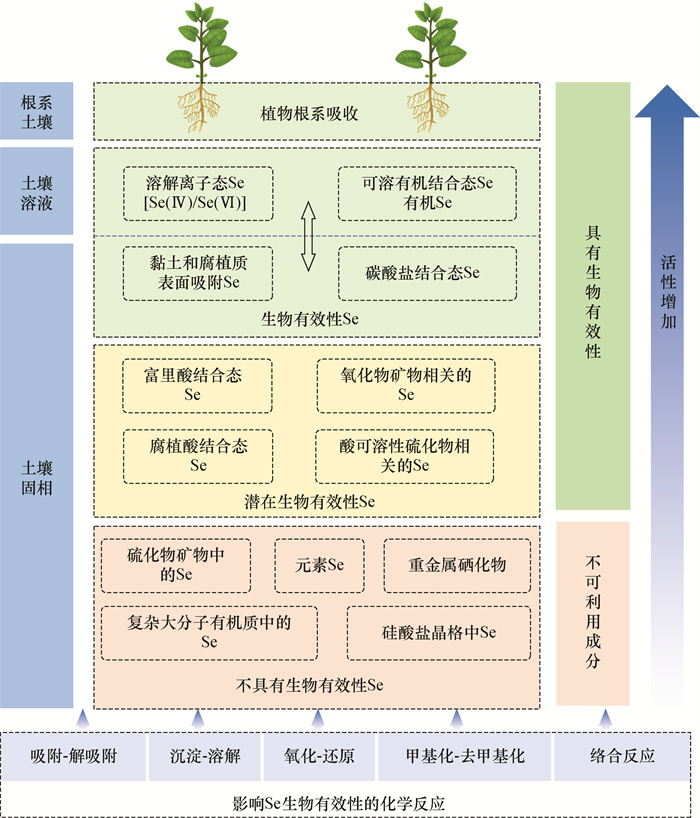
 下载:
下载:
